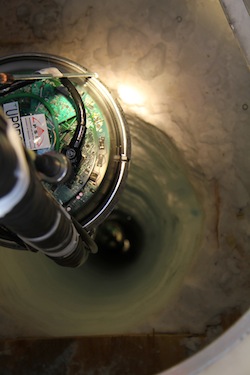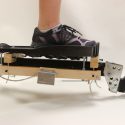International astrophysics reaches Milwaukee
Trips to the South Pole usually require a lot of specialized equipment, but Nils Irland’s packing list for his November 2012 visit included some items unusual even by those standards: a specially designed video camera, extra batteries, and lots and lots of data storage.

A Digital Optical Module in the IceCube array descends into the ice in 2010.
Photo: Robert Schwarz
Irland, a staff member at the Wisconsin IceCube Particle Astrophysics Center (WIPAC) at the University of Wisconsin–Madison, carried a high-tech camera from the Daniel M. Soref Planetarium at the Milwaukee Public Museum to shoot footage for a new full dome planetarium show about the IceCube Neutrino Observatory. One of the biggest astrophysics projects in the world, IceCube is a massive telescope built into the Antarctic ice sheet at the South Pole.
Now a piece of IceCube is coming back to Milwaukee. On Monday, April 22, WIPAC staff will be at the Milwaukee Public Museum to explain how they are exploring the universe from the South Pole and what it is like to work in one of the harshest environments in the world. The event is part of a statewide program funded by WIPAC and the Ira and Ineva Reilly Baldwin Wisconsin Idea Endowment.
“It’s a great story to tell. There are powerful visuals, a great South Pole story, and a link to amazing things that are happening out in the universe,” says Robert Bonadurer, planetarium director.
From 10 a.m. until 3 p.m. and 6 to 7 p.m., free hands-on activities will be available for all ages to explore physics, computer programming and ice drilling, and to learn about how and why IceCube was built. At 7 p.m., a presentation by UW-River Falls physicist and IceCube researcher Jim Madsen will begin, including a sneak preview of the IceCube planetarium show with video footage from the South Pole. Reservations are required for the lecture and planetarium show and can be made by calling 414-278-2714.
It took more than a decade and the efforts of an international collaboration of scientists, engineers and technicians to design, test and build IceCube, which collects evidence of ghost-like particles called neutrinos. The worldwide effort is supported by the National Science Foundation and rooted squarely in Wisconsin, with key partners at the University of Wisconsin–Madison and staff and suppliers from around the state.
“I’m very excited to be part of a great project that is studying the universe in a new way. I look forward to describing how we built this incredible instrument and what it is telling us, and seeing the full dome footage from the South Pole,” says Madsen.
The full film will begin showing at the Planetarium this fall.
Also on April 22, UW–Madison physics professor Stefan Westerhoff will present a special colloquium at UW-Milwaukee about another WIPAC project, the High Altitude Water Cherenkov array (HAWC). His talk is scheduled for 4 p.m. in Physics Lecture Hall 137.
Located on the slope of Mexico’s tallest mountain, Pico de Orizaba, HAWC is a gamma ray observatory searching for the sources of the highest energy cosmic rays in the universe. HAWC is funded by the National Science Foundation and led by the University of Maryland. WIPAC faculty, scientists, and students are active on the project.
More information about the upcoming events can be found at the Bringing the Universe 2 Wisconsin website.
Tags: IceCube, international, museums, research, space & astronomy



